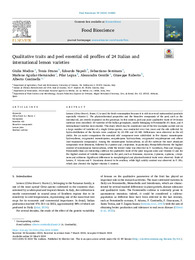Título :
Qualitative traits and peel essential oil profiles of 24 Italian and international lemon varieties |
Autor :
Modica, Giulia 
Strano, Tonia 
Napoli, Edoardo
Seminara, Sebastiano
Aguilar Hernandez, Marlene Gladys 
Legua, Pilar 
Gentile, Alessandra 
Ruberto, Giuseppe 
Continella, Alberto  |
Editor :
Elsevier |
Departamento:
Departamentos de la UMH::Producción Vegetal y Microbiología |
Fecha de publicación:
2023 |
URI :
https://hdl.handle.net/11000/36674 |
Resumen :
Lemon (Citrus limon L. Burm. f.) is used for fresh consumption because it is rich in several nutraceutical products
especially vitamin C. The physicochemical properties and the bioactive compounds of the peel, such as the
essential oil, are strictly depended on the genotype. In this context, peel and juice qualitative traits of 24 lemon
cultivars were described: 20 varieties of the Italian germplasm, mostly belonging to Femminello (F.) lines, and 4
international varieties were studied. This study which may be considered one of the few examples carried out on
a large number of varieties of a single Citrus species, was conducted over two years and the oils collected by
hydro-distillation of the flavedo were analyzed by GC-FID and GC-MS. Differences were observed in the oil
yields. For an easier comparison the essential oils’ component were subdivided in five classes: monoterpene
hydrocarbons, oxygenated monoterpenes, sesquiterpene hydrocarbons, oxygenated sesquiterpenes and others
(not terpenoidic compounds). Among the monoterpene hydrocarbons, in all the cultivars the most abundant
compounds were limonene, followed by β-pinene and γ-terpinene. In particular, Monachello showed the highest
content of monoterpene hydrocarbons, while the lowest value was observed in F. Carrubaro, Fino and Akragas.
Femminello lines are interesting cultivars for qualitative traits of the juice (organic acids and vitamin C) and for
the highest content of volatile compounds in the peel, such as limonene, myrcene, β-pinene, α-pinene, γ-terpinene and sabinene. Significant differences in morphological and physicochemical traits were observed: fruits of
Lemox, F. Adamo and F. Scandurra showed to be seedless, while high acidity content was observed in F. 2Kr,
which also showed the highest vitamin C content.
|
Palabras clave/Materias:
Citrus limon (L.) Burm. f
Germplasm
Essential oils
Bioactive compounds
Lemon juice
Seedless cultivar |
Tipo de documento :
info:eu-repo/semantics/article |
Derechos de acceso:
info:eu-repo/semantics/openAccess |
DOI :
https://doi.org/10.1016/j.fbio.2024.103881 |
Publicado en:
Food Bioscience Volume 59, June 2024, 103881 |
Aparece en las colecciones:
Artículos - Producción vegetal y microbiología
|
 La licencia se describe como: Atribución-NonComercial-NoDerivada 4.0 Internacional.
La licencia se describe como: Atribución-NonComercial-NoDerivada 4.0 Internacional.
.png)
